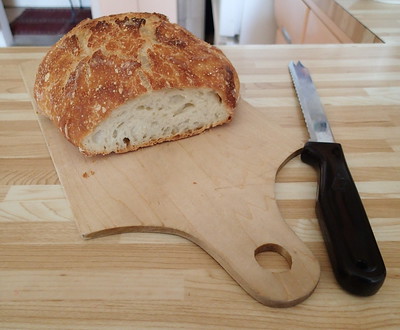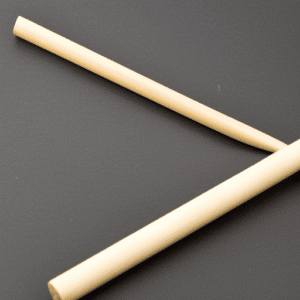Sharpening a knife at home is easy, but what about when you have a serrated knife? How does that alter the scenario?
Knowing how to sharpen a bread knife requires more thought than a normal knife. You can even buy kitchen knives for the home where you slide them into their cover, and the cover sharpens the knife blade every time.
While that may have been a great thing, it’s not something that happens with a serrated bread knife. Instead, you need to take a different approach and be aware that it takes longer to sharpen a serrated knife than an ordinary one.
The Problem With Bread Knives

The problem with bread knives is all to do with the blade edge. Of course, this also applies to any quality serrated knife.
With a serrated knife blade, you do not have one single sharp edge. Each tooth must be sharpened, whereas straight-edge knives have a single edge. This means it takes considerably longer, as sharpening steel is not a quick job in the first place, even with sharpening rods.
This time issue puts people off trying to create those sharp edges. They see it as taking too long, but that’s not always the case.
The Tools
They are the same for any knife sharpening when it comes to tools. Just because it’s a bread knife doesn’t change the tools you would use.
However, the same tool you will use should depend on how you plan on sharpening those serrated knives.
A Ceramic Sharpening Rod
The first method for sharpening that serrated edge is to use a ceramic sharpening rod. This is a common tool for knife sharpening, but it’s the method you need to use to deal with those serrated blades.
A Tip for Those Serrated Blades
When sharpening a serrated knife, make sure you manage to choose a sharpening rod that fits into the spaces on the serrated blade. This is key. It will make life significantly quicker and more manageable when you want to sharpen a serrated knife.
Using a sharpening rod that is too thick will mean it cannot get to the bottom of the serrated blade. That will render the actual sharpening useless. When sharpening serrated knives, you must be able to get to the bottom of the space with the sharpening rod. Not having the right tools will mean your knife sharpener can only get to work on the blade’s tip, but that’s not the main part of a knife’s serrations.
If we even look at any sharpening rod. They come in different thicknesses, but your bread knife may have a 10 mm gap, so an 8 mm thick sharpening rod won’t touch the sides. Alternatively, a 14 mm thick tool will only hit the side of the blade at the top, and it won’t slide smoothly to the bottom.
Using Ceramic Rods

So if we can presume you have realised the size of the gap in the serrated knife, we can look at sharpening all of those bevelled serrations.
When sharpening a serrated knife, you only sharpen it on one side. Look at the bread knife to see which side contains the serrations.
Take the sharpening rod, and lay it down on the blade. It would help if you moved the rod up and down on each side of the blade for manual sharpeners. That does mean covering each side of those individual curved serrations.
But don’t just move the sharpening rod and then move along. After a few passes, check the edges and make sure you are hitting the entire edge. It may require you to hold the rod at a slight angle to get the full side of the blade.
Then, repeat this process with every tooth on the serrated blade at the same angle.
Safety First
When you want to sharpen a serrated knife, then one helpful tip is to lay the serrated knife on the edge of a table. Make sure the serrated blade is on a flat surface. This can help prevent accidents, and it will also provide you with a greater sense of control over the sharpening process.
Dealing With the Burr of a Serrated Bread Knife
When you sharpen serrated knives, something else happens to the opposite side of the serrated knife blade, which is the creation of a burr.
You need to remove the burrs before you can use your new sharpened knife. This burr consists of some of the steel effectively being pushed up into a ridge, and it will affect the way the knife will then operate.
Still, don’t worry because removing a burr is easy to do. You can either take your sharpening tool or use a sharpening stone. Then run the tool across the burrs just once. It will remove them with ease. However, it would help if you were more careful because applying too much pressure can scratch the blade. This can be a disaster with cheap knives, as the quality of the high-carbon steel used in the knife won’t be to the same standard as more expensive serrated knives.
Alternatively, the best method to sharpen a serrated bread knife is to take your ceramic rod and run it over the burrs. This will remove them, and it should leave your knife blade looking perfect and without any damage.
An Alternative for Sharpening Serrated Knives
Suppose you don’t want to sit there and do most of the manual work on your own when sharpening knives. Well, there is an alternative you can try.
Something as simple as a Spyderco sharp maker has the potential to make your life easier when dealing with those serrations. However, you need to know how to sharpen those serrations using this method, as it is slightly different from sharpening other kitchen knives, such as a paring knife.
Here, you must make sure you have placed the angular part of the sharpening rod towards the bevelled edge containing the serrations. Then, the flat side needs to be put into the holder on the other side.
Next, move the side containing the serrations slowly along the sharpener. This is the method you would use when sharpening a regular knife, and the process still works with most serrated knives. However, the main point here is to take your time. Move slower than you would do with a normal knife, or you could potentially damage the serrations.
Remember the Burrs Again
You must remember to deal with the burrs that will appear when sharpening steel. For this, run the other side of the blade on the other rod. It will remove them with one or two passes.
Using an Electric Sharpener on a Serrated Knife
The final method is for people who don’t want to sharpen steel manually, and that’s to use an electric sharpener.
The key here is to ensure that your electric sharpener has a setting for dealing with a high-quality serrated knife. This is important, as you could turn a dull knife into a broken one if you are not careful.
Often, people tend to use the final polishing phase on an electric sharpener. But it would help if you only pulled this once or twice. Doing this too much with an electric knife sharpener will only damage the knife. The worse thing that could happen is you could break the edge easily.
The Problems of Sharpening a Bread Knife Blade
So what are the potential problems you can come across with this process? The biggest issue is connected to electric sharpeners. You cannot keep the same control over how you need to sharpen that straight edge.
Serrated knife sharpening is quite a specific job to get that sharp edge. But remember, you are honing steel, and there’s not a specific serrated knife sharpener that you can use as your go-to tool.
The best approach has to be the ceramic rod. It does take longer; still, it will sharpen each serration with ease. However, as we said earlier, you do need to have the correct size of the rod if you want things to be sharpened to the full length of the serration. After that, check those burrs, as they can remain partially attached if you do not go through the process of buffing them off.
But overall, trying to sharpen a bread knife should not be that difficult. Yes, it will take time, but if you have an excellent bread knife that does a fantastic job when sharp, taking the time to sharpen it is worth considering.
Ready to Slice That Bread?
Now you know how to sharpen a bread knife! Although it seems too overwhelming compared to simply sharpening a typical knife, you need to remember that it’s not complicated, even if it requires patience to sharpen every tooth at the right angle. These are essential knives, and caring for the blades and serrations requires some work.
Taking care of your serrated knife will be worth it once it’s functioning like brand new. You are now eating your bread at any meal of the day.

